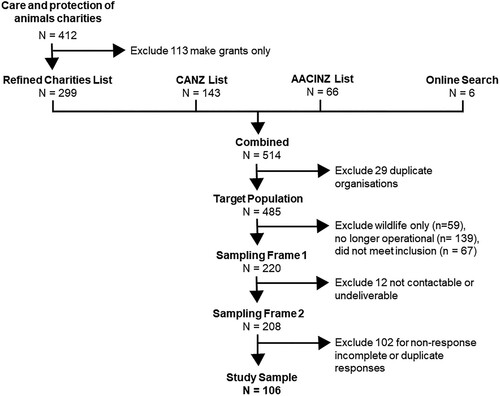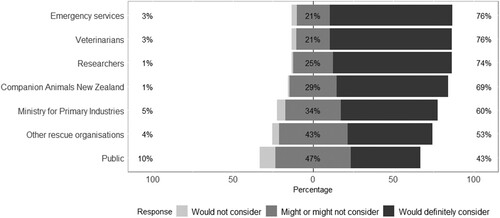Figures & data
Figure 1. Flow diagram showing the process used to generate the study sampling frame for an online survey of New Zealand companion animal rescue organisations (CARO). All organisations in the New Zealand Charities Register whose main sector was “care and protection of animals” were identified and those whose main activity was “makes grants to other organisations” were excluded. Additional CARO were identified via national animal welfare organisations (CANZ), local animal rescue networks (AACINZ) and a Google search (e.g. “animal rescue,” “dog,” “cat,” “fostering,” “pet adoption”). Duplicate organisations, and those that solely provided services for wildlife or marine life were excluded.

Table 1. Number (%) of New Zealand companion animal rescue organisations (CARO) responding to an online survey or with publicly available location information, and number of estimated households, by region.
Table 2. Number (%) of companion animal rescue organisations (CARO; n = 106) in New Zealand caring for different types of animals per year and the median (and IQR) number of that animal each CARO cared for, as reported by respondents to an online survey.
Table 3. Number (%) of companion animal rescue organisations (n = 86) in New Zealand that care for cats or dogs, that provide different types of services as reported by respondents to an online survey.
Table 4. Distribution of staff types of companion animal rescue organisations that care for cats or dogs (n = 72) that responded to an online survey.
Table 5. Number (%) and proportion of companion animal rescue organisations (n = 72) that care for cats or dogs that have different numbers of full-time and total staff and their proportions of volunteers to total staff as reported by respondents to an online survey.
Table 6. Number of staff and animals cared for by companion animal rescue organisations that care for cats or dogs (n = 67) and which responded to an online survey.
Figure 2. Chart showing willingness of companion animal rescue organisations that responded to an online survey (n = 106) to consider sharing anonymised data with different groups.

